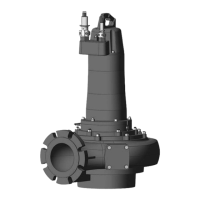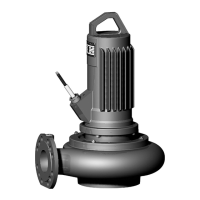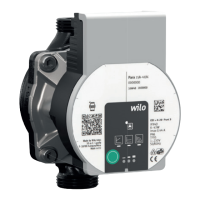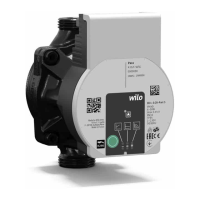en Maintenance and repair
34 WILO SE 2017-06
can cause the pump to break down. Regular inspections can therefore largely prevent
major secondary damage and reduce the risk of total breakdown. In this regard, it is re-
commended to use remote monitoring for regular inspections.
9.6.2 Visual inspection of the power
supply cable
The power supply cables must be checked for:
▪Bubbles
▪Cracks
▪Scratches
▪Abrasion
▪Crushing
If the power supply cables are damaged, the pump must be decommissioned immedi-
ately! Customer service must replace the damaged power supply cable. The pump may
only be started up again once the damage has been properly remedied.
CAUTION!Water may penetrate into the pump due to the damaged power supply
cables! Water ingress leads to total damage of the pump.
9.6.3 Visual inspection of accessories
Accessories must be checked for:
▪Correct fixation
▪Smooth function
▪Wear symptoms
Detected defects must be repaired immediately or the accessories must be replaced.
9.6.4 Visual inspection of coatings and
housing for wear
The coatings and housing parts must not show any signs of damage. If there are de-
fects, the following must be observed:
▪If the coating is damaged, it must be restored.
▪Contact customer service if housing parts have worn out!
9.6.5 Function test of the monitoring
equipment
To test resistances, the pump must be cooled down to the ambient temperature!
9.6.5.1 Test the resistor of the internal
electrodes for motor compart-
ment and sealing chamber control
(FK34 and FK42 only)
The internal electrodes are switched in parallel. During testing, all the electrodes are
measured together.
Measure the resistor of the electrodes with an ohmmeter. The measured value must ap-
proach “infinity”. For values ≤30kOhm, there is water in the motor compartment or the
sealing chamber. Change the oil in the sealing chamber and measure again.
NOTICE!If the value is still ≤30kOhm, contact customer service!
9.6.5.2 Test the resistor of the temperat-
ure sensor
Measure the resistor of the temperature sensors with an ohmmeter. The following
measured values must be complied with:
▪Bimetallic strip: Measured value = 0Ohm (passage).
▪PTC sensor (PTC thermistor): Measured value depends on the number of sensors in-
stalled. At PTC sensor has a cold resistance of between 20and 100Ohm.
– With three sensors in series, the measured value is between 60 und 300Ohm.
– With four sensors in series, the measured value is between 80 und 400Ohm.
▪Pt100 sensor: Pt100 sensors have a resistance value of 100Ohm at 0°C. Between 0°C
and 100°C, the resistance increases by 0.385Ohm every 1°C.
At an ambient temperature of 20°C, the resistance is 107.7Ohm.
9.6.5.3 Testing the resistor of the ex-
ternal electrode for sealing cham-
ber control
Measure the resistor of the electrode with an ohmmeter. The measured value must ap-
proach “infinity”. For values ≤30kOhm, if there is water in the oil – change the oil!
9.6.6 Note for the use of shut-off ball
cocks
If shut-off ball cocks are installed on the drain holes, observe the following points:
▪Remove the screw plug before opening the shut-off ball cock.
▪To drain the operating fluid, turn the lever to the direction of flow (parallel to the shut-
off ball cock).
▪To close the drain hole, turn the lever so it is at right angles to the direction of flow (to
the shut-off ball cock).
▪After closing the shut-off ball cock, screw in the screw plug again.

